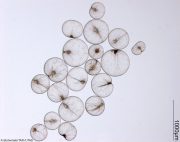Biosphere | Zoology | Zooplankton
Type of resources
Topics
Keywords
Contact for the resource
Provided by
Years
-

The Guide to the Marine Zooplankton of south eastern Australia, is an interactive tool providing a comprehensive, fully illustrated means of identification for the major zooplankton located in south eastern Australia. This new identification guide to local marine zooplankton is available online at: http://www.imas.utas.edu.au/zooplankton This is the result of collaboration between the Marine Research Laboratories and School of Zoology, University of Tasmania, and the Australian Antarctic Division. Please note that the full contents of the site will be available on (Free) CD-Rom
-
Mesozooplankton community composition and structure were examined throughout the D’Entrecasteaux Channel, Huon Estuary and North West Bay, Tasmania, from November 2004 to October 2005, the data represented by this record was collected on the 05/04/2005. The composition of the mesozooplankton community was typical of inshore, temperate marine habitats, with seasonally higher abundance in summer and autumn and lower numbers in winter and spring. Copepods were the largest contributors to total abundance across all seasons and stations, while cladocerans and appendicularians were proportionally abundant in spring and summer. The faecal pellets of these three main groups, along with those of krill and amphipods, also contributed significantly to material recovered from sediment traps. Meroplanktonic larvae of benthic animals showed short-term peaks in abundance and were often absent from the water column for long periods. Spatially, North West Bay and the Channel had a higher representation of typically marine species, including Calanus australis and Labidocera cervi, while truly estuarine species, such as the copepod Gladioferens pectinatus, were more important in the Huon Estuary.
-
Mesozooplankton community composition and structure were examined throughout the D’Entrecasteaux Channel, Huon Estuary and North West Bay, Tasmania, from November 2004 to October 2005, the data represented by this record was collected on the 13/10/2005. The composition of the mesozooplankton community was typical of inshore, temperate marine habitats, with seasonally higher abundance in summer and autumn and lower numbers in winter and spring. Copepods were the largest contributors to total abundance across all seasons and stations, while cladocerans and appendicularians were proportionally abundant in spring and summer. The faecal pellets of these three main groups, along with those of krill and amphipods, also contributed significantly to material recovered from sediment traps. Meroplanktonic larvae of benthic animals showed short-term peaks in abundance and were often absent from the water column for long periods. Spatially, North West Bay and the Channel had a higher representation of typically marine species, including Calanus australis and Labidocera cervi, while truly estuarine species, such as the copepod Gladioferens pectinatus, were more important in the Huon Estuary.
-
Mesozooplankton community composition and structure were examined throughout the D’Entrecasteaux Channel, Huon Estuary and North West Bay, Tasmania. The data represented by this record was collected as part of a grazing study conducted in Hideaway Bay, Huon Estuary (20-21 September, 2005). The grazing impacts of microzooplankton and mesoplankton on the phytoplankton communities were examined during several process studies. Experiments with mesozooplankton grazers were restricted to dominant omnivorous copepods (e.g. Acartia tranteri, Paracalanus indicus, Centropages australiensis) cladocerans and appendicularians. Grazing rates of microzooplankton reached as high as 96% of daily primary production, while that of mesozooplankton herbivours was never greater than 20%. Trophic interactions between the species are complicated by the recent arrival of the heterotrophic dinoflagellate Noctiluca scintillans to the region. This species grazes heavily on phytoplankton, smaller zooplankton and faecal pellets. Noctiluca scintillans accounted for up to 20% of mesozooplankton abundance in autumn and it is capable of both suppressing zooplankton abundance and reducing the sedimentation of faecal pellets to the seafloor.
-
The most recent field study of the Little Swanport estuary, Tasmania carried out by Crawford et al. (2006) collected monthly samples at sites throughout the estuary between January 2004 and January 2005. Measurements included water column nutrients, chlorophyll-a, dissolved oxygen, salinity, phytoplankton, zooplankton and oyster growth. This work demonstrated that freshwater flows had a significant effect on salinity, turbidity, dissolved oxygen and nutrient levels in the estuary. However, monthly sampling didn’t provide the temporal resolution necessary to detect potential flow-on effects on the biology (e.g. phytoplankton and zooplankton dynamics, oyster growth). To gain an improved understanding of the temporal dynamics of the estuary, including the response to freshwater flow, samples were collected weekly (chlorophyll-a), fortnightly (nutrients and zooplankton) and bimonthly (oysters) between March 2006 and June 2008 at a site in the lower estuary where the majority of oysters are farmed
 IMAS Metadata Catalogue
IMAS Metadata Catalogue